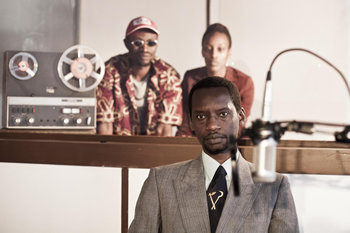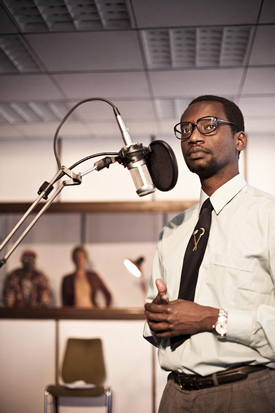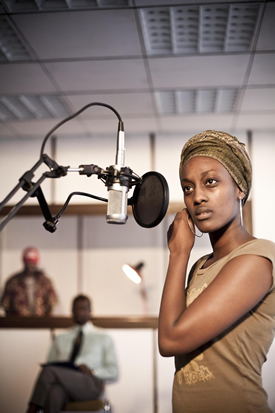
Be There
By Anita Rákóczy
Hate Radio
By Milo Rau
with the International Institute of Political Murder (IIPM)
Theatertreffen 2012
”I don’t believe there is an end to genocides.
If there was one genocide, there will be many more.” [1]
It is always exciting to look behind the scenes – get an insider’s view of a broadcast that’s just being made, be there in a kitchen where the dinner is on the stove and someone else is doing the cooking. We enjoy being voyeurs. We love it especially because of its passivity. Theatertreffen 2012 in Berlin listened to our secret wishes and presented a large terrarium in which, between glass walls, we could eavesdrop on cheerful radio hosts in Rwanda facilitating one of the most ferocious genocides of the last half century.
The festival opened with a new management team this year. Iris Laufenberg, who had been the leader of Theatertreffen since 2003, was replaced by Yvonne Büdenhölzer, and Thomas Oberender was appointed the new Intendant of Berliner Festspiele, the festival’s sponsor organization, after Joachim Sartorius’s resignation. For several decades, the Theatertreffen jury had selected the season’s ten most remarkable German language theater productions out of the traditional repertory theater premieres. The past couple of years, however, have witnessed a strong opening towards independent theater companies and alternative theater groups. In both 2011 and 2012, three festival productions out of ten came from the independent theaters, signifying that that scene is of growing importance in Germany. The glass cage that forces the audience to silently bear witness and be there belongs to an independent production: Milo Rau’s overwhelming documentary drama, HATE RADIO.
On 6 April 1994, the private Falcon 50 jet of the Rwandan President, Habyarimana, was shot down by missiles near Kigali International Airport as it was about to land. This incident served as the pretense and starting point for the brutal genocide that took place in Rwanda during the months of April, May and June, during which time the Hutu majority of the African state massacred an estimated 800,000 to 1,000,000 of its Tutsi minority as well as a great number of moderate Hutus. The mass murder was carried out with machetes, sticks and guns, with unimaginable cruelty, and with the aim of the humiliation and total annihilation of the Tutsi population.
HATE RADIO draws our attention to the Rwandan genocide by reconstructing the studio of the country’s most popular radio station, Radio-Télévision Libre des Mille Collines (RTLM), with historical accuracy. This station was a key organizer of the massacre, and its role and responsibility cannot be overestimated. Not only did the staff of RTLM carefully prepare the genocide like an advertising campaign; it followed and helped the attacks of the Hutu militia with undescribable sarcasm and thirst for blood. After the death of Habyarimana, it was mandatory for the Hutu militia to listen to RTLM at road blocks and during their operations. RTLM spread the word about Tutsis who had survived attempted murder and Tutsi families in hiding so that the Hutu militia could hunt them down. Tutsis likewise listened to RTLM, precisely to get a hint about the location of a possible next attack. With methodically built up psychological manipulation, RTLM got through to the whole Rwandan population; its broadcast could not be avoided.
Milo Rau, the director and script-writer of HATE RADIO, was born in Switzerland in 1977, and shuttles between Zurich and Berlin at present. He is currently working on his Ph.D., and his research topic is dealing with the aesthetic of re-enactments. In addition, he is the director and founder of the International Institute of Political Murder (IIPM), an organization established in 2007 for the purpose of promoting and bringing forth the re-enactment of traumatic historical events by means of theater, film, fine arts, and research. One of IIPM’s latest projects, the re-enactment The Last Hours of Elena and Nicolae Ceausescu (2009-2010), has been performed in Romania, and is considered a great step forward towards that country’s coming to terms with its past.
HATE RADIO is based on in-depth interviews, thorough on-site research, oral history, and the reconstruction of one hour’s broadcasting by RTLM, including the jokes, jolly remarks, riddles, patriotic encouragement and naked racist ideology of the radio hosts. These presenters, Valérie Bemeriki, Katano Habimana and the white Italo-Belgian presenter Georges Ruggiu, mixed their incitements to murder with sports reports and the latest Congolese and European hits from the music charts. The re-enactment, as in all previous IIPM projects, is based solely on research material. However, the actual broadcast was not exactly like the stage broadcast. As Milo Rau explains in an interview conducted by Rolf Bossart, ”Although the live performance is admittedly orientated on the original broadcast in every detail, it does not depict a particular transmission date. Rather, it is a condensation of the transcripts: I have created one hour out of one thousand, and then further compressed and rhythmized it in the course of working with the actors.”
[2]

Headphones are distributed among the audience. The auditorium is divided into two symmetrical halves, with the glass box in the center of the stage. Its walls are projection surfaces facing the audience. The images of four people appear side by side, close-ups of former perpetrators and victims -– men and women. Two screens, eight eyes against two groups of voyeurs opposing each other. The projected people are standing still, looking straight at us with somewhat bored or rigid faces. The first man is in his forties, wearing a light green cotton top, blue linen shirt and a distinctive watch. The middle-aged woman with large round earrings next to him is in a tight blue cotton top, khaki shirt and jeans. The third man is clasping his arms together, wearing a light suit and a white shirt. The fourth person is a woman in her late thirties perhaps, in jeans, a light shirt and a scarf around her neck. I am sitting on the right side, and cannot stop wondering whether the other half of the audience is attending the same production I am. Tense drum music comes from the headphones well before the production begins, increasing our heart-rate, preparing us for the events to come. At times, the projected people vanish, and only the empty white wall remains in the background. It is so easy to disappear.
The importance of biographical pararells between the artists and the re-enacted moments of history in his productions has always been crucial to Rau. Therefore, he chose Rwandan actors, genocide survivors, for the roles of the extremist Hutu radio hosts and DJs. One of these, the Kigali-born Dorcy Rugamba, survived the genocide, but most of his family members were victims of the murderous rage. Rugamba’s artistic work consists of pieces that focus on the events of 1994 (Rwanda 94; Bloody Niggers; L’investigation).
Subtitles inform us that the production depicts the story of a hundred days. At first the audience is introduced to pieces of oral history delivered by the projected actors. One of the screens shows a trial. One of the hosts, Georges Ruggiu, pleads guilty. He pleaded not guilty in 1997 when he was finally captured, but changed his mind and confessed in 1999. From flashbacks we find out that President Habyarimana had offered Ruggiu a job at a radio station, RTLM. In the next projected scene a woman talks about the radio. In her experience, RTLM was the voice of authority. She once heard a broadcast in which one of the presenters told the listeners about the Tutsis: ”We have to wipe them out. We have to finish them.” A man in the following section is a Tutsi survivor -– while he managed to escape, his entire family was exterminated. While listening to Bruckner’s Symphony No.7, we are informed that the Rwandan president’s plane has crashed and blame is laid on the Tutsis. At this point, the white projection screens rise on both sides like shutters, and we finally get a glimpse inside the terrarium: the radio station on an average day.
”Kigali 9 a.m. Courage!” The three radio hosts are having a hell of a good time inside the studio. Chain smoking. Air conditioning. We are almost sweating together with this dedicated team in the African heat. The broadcast is taking place in a flamboyant rhythm, with remarks like ”Tutsi cockroaches” flying in the air. On air, to be exact. Then comes a hate song about Tutsis, ”Our fortune is that they are few/ All the better that I hate them.” There is a soldier sitting next to the wall in green uniform, keeping order, taking care of the presenters. His young face is motionless. I cannot stop wondering what he might be thinking while overhearing the broadcast -– whether he is a fellow Hutu fighter or simply afraid for his Tutsi life, possibly visualizing his family being tortured to death to the accompaniment of the lively pop music of RTLM.
Some minutes later Jean Pierre Kajuga, a local caller, expresses his opinion on air, and then we can hear Georges Ruggiu saying that the USA is against them and so is Clinton, so what is happening here in Rwanda is just another colonialist violation, hidden under the name of "genocide." The three cheerful presenters are sitting round a table, speaking into microphones. One, Valérie Bemeriki, becomes immersed in a monologue about Hitler and the Bible, and draws a parallel between the Tutsis and the Aryan race. The parallels are obvious, she says, allowing no objections. An authority, RTLM’s most beloved female host, has declared it; therefore it is so. No need to give it a second thought. She continues with easy-flowing words: Tutsis are cockroaches. Complete annihilation. Absolute destruction. ”Tutsis rape God and would rape the Devil if he would let them.”
Then comes some music for our souls to enjoy in between two nation-defending brainwashes -– Nirvana’s ”Rape me.” With assertive psychological dramaturgy, RTLM will not let our spirits sink. The hit calls for action. Several thousand raped Tutsi women could testify to it. While the music is playing, the presenters take a rest. They have become weary of agitating for murder. In Buchenwald there was a chair next to the executioner so that he could rest when he got tired of shooting people whose height was being measured in the adjacent doctor’s consulting room. A small sign of humanity. The time of milking and the time of harvest. The time for working and the time for rest. We in the audience are all there, sitting, listening, doing nothing. Taking it all in. It is unbearable.
”Hunt them down!” The show must go on. Another Hutu caller is on the line, eleven-year-old Honeste. Then comes the youngest caller of the day, a boy who is only eight, but old enough to kill a cockroach -– the child announces it on air proudly, and the presenters confirm it. He is old enough to talk in metaphors, a mature kid for his age. The soldier is standing by the wall. The presenters command him to pick up the paper pellets from around the dustbin and throw them out. By-products of their focused preparation? Or a creepy power game? We don’t find out. History quiz at 9:35 a.m. ”Have pen and paper. Now, I will ask the first question: ’No Hutu retreats.’ Who said it in what circumstances?” The answers are to be sent to RTLM, Competition, Post Box 2948, Kigali. At the end of the war, we should not forget to commemorate the Hutu heroes.
Reel 2 Real’s ”I Like to Move It” is sweeping through the air. People have danced to this song all over the world, as children, teenagers and adults. Songs unite us. This one appeared on the Billboard Hot 100 chart in 1994, and became the number one hit in France. It gives our host another chance for a short siesta. Then one presenter starts singing aloud with renewed energy, ”Be happy, friends! The Tutsis are destroyed. Be happy, friends! God is always just.” Rwanda is a Catholic country. Tutsis are only ten per cent of the population. The RTLM presenters call for their total annihilation. They command the listeners to kill all the Tutsis –- grandmothers, grandchildren, so that no one should hear their names anymore. Wipe out their names. I am sitting there paralysed. Then the hosts read out the names of Tutsi soldiers. They laugh sarcastically each time they pronounce a rank, ”Corporal…,” and continue thus, ”bye-bye Steve...” The members of the audience are left to imagine the future of these Tutsi soldiers, all that might have happened to them a few minutes after the RTLM broadcast.

Finally, it is time for the international and sports news. The world does not stop, life goes on, football events demand attention. A great number of callers express their gratitude for the program and its encouragement. ”Courage, and till tomorrow ” -– with this slogan, the shutters of the radio station slowly start to roll down. Georges Ruggiu, who finally turned himself in, looks out of the glass window. Valérie Bemeriki was later sentenced to life imprisonment. Ruggiu was released in 2010. Katano Habimana disappeared without a trace. The RTLM building is now a jewelry shop.
In the end, a man starts talking. He survived the genocide and left Rwanda, but decided to return to his country for Froduald Karamira’s execution. Karamira was a war criminal, a politician born into a Tutsi family. As an adult he became accepted as a Hutu –- he was the vice president of the MDR Party and the leader of its extremist wing called ”Hutu Power.” He was found guilty of genocide and crimes against humanity and sentenced to death in 1997. His public execution took place in Nyamirambo Stadium, Kigali, on 24 April 1998. The survivor wanted to watch it from the front row. ”Karamira and the others were wearing suits with a target on them, here, over the heart. I found all this very hateful. The bullets were already hailing -– there was a tremendous bang -– it was all over very quickly. A policeman approached each one for the coup de grâce. A lunatic started to cry for joy. I was disgusted by the whole thing. It did not mean anything to me, not even a form of revenge. That is when I realized that none of this could be made up for.”
[3]
During the post-show-discussion, the actors commented that they had had doubts about taking HATE RADIO to Rwanda, in front of an audience that had lived through this terror. However, they got positive feedback. Playing the production, especially in Rwanda, has been of crucial importance to the artists. ”It was a must,” one of them said. ”We played it right in the building where the RTLM radio studio used to be. It was a historical moment.”
The languages of the production are French and Kinyarwanda with English and German subtitles. This attribute of HATE RADIO got much critical feedback during Theatertreffen Festival, with some critics claiming that the language barrier made the piece less graspable for the audience. I believe, however, that the documentary drama would have lost a great deal of authenticity with a solely English or German translation. The multiple subtitles made the production fully accessible, even if at times it required a little more effort than usual to follow. Let’s face it, shouldn’t a little extra effort be the minimum requirement when watching a production like HATE RADIO? Reading subtitles is surely the least we can do.
Given the documentary nature of HATE RADIO, there is no need to look for dramatic conflict or plot in the production. Quite enough conflict arises from the tension between the passivity of the audience and the content of all that is said onstage. A triple passivity is on display. The glass terrarium emphasizes the fourth wall between audience and the stage action. Secondly, the sound transmission of the actors is not direct but processed though headphones and subtitles in several languages. Finally, the permanent impotence of the audience member, a voyeur just sitting there doing nothing, ironically creates a mental and emotional state of lasting involvement. We are doomed to soak it all up, take it with us, and never find peace again.
______________________
Special thanks to Bernard Adams for proofreading; also to Jagoda Engelbrecht and Daniel Seiffert for the production photos.
Photos: copyright Daniel Seiffert
1. Milo Rau, in International Institute of Political Murder, HATE RADIO (Verbrecher Verlag Berlin, 2011), 33.
2. Ibid, 7.
3. Ibid, 33.
